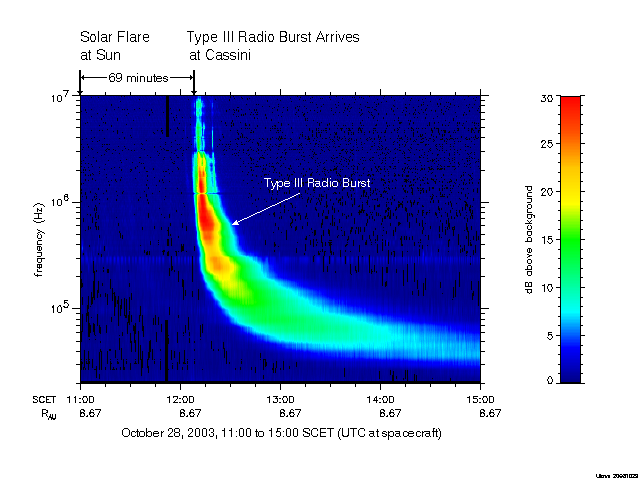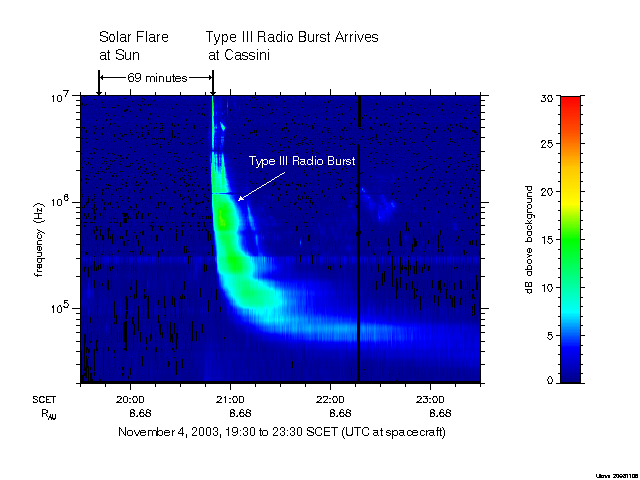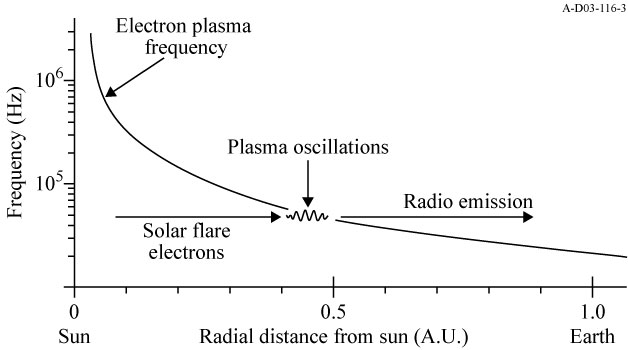Click on spectrogram below to play associated audio.




The above frequency-time spectrograms show the type III solar radio bursts produced by the very intense solar flares on October 28, 2003, and November 4, 2003, respectively. Type III solar radio bursts are produced by very energetic (1 to 100 keV) electrons emitted by a solar flare (see the illustration below). As the energetic electrons from the solar flare move outward from the Sun, they excite oscillations at the electron plasma frequency, fp,which is a characteristic oscillation frequency of the ionized gas (called plasma) that surrounds the Sun. The plasma oscillations in turn generate radio emissions at fp (and also at 2fp) via a mode conversion process. These radio emissions then propagate outward from the generation region at the speed of light, which is about 8 minutes per Astronomical Unit (A.U.). Since the Cassini spacecraft was at a radial distance of 8.67 A.U. from the Sun, these radio emissions took 8.67 x 8 min = 69 minutes to first reach the spacecraft, where they were detected by the Radio and Plasma Wave Science (RPWS) instrument. Because the electron plasma frequency declines rapidly with increasing distance from the Sun, the emission frequency then rapidly decreased as the solar flare electrons moved outward from the Sun, taking about three hours to go from 107 Hz to about 3 x 104 Hz (see the spectrogram).
Since the ear cannot hear frequencies in this frequency range, the frequencies in the audio wave file have been shifted downward into the audio frequency range so that one can hear the radio emission (107 Hz has been scaled down to 104 Hz). Also the 4-hour duration of the recording has been shortened to 15 seconds to reduce the recording to a reasonable length.
Don Gurnett
AVI animations are available for the October 28 and November 4 type III radio bursts. These feature a synchronized cursor that moves across the spectrogram as the sound plays.
RealPlayer streaming video feature on Cassini RPWS recording of type III radio burst (from KSC)
Listen to "Geomagnetic Storm Visits Earth" at NPR
UI's Don Gurnett Captures Sound Of Solar Storm - UIowa press release
Enormous X-ray solar flare seen by SOHO - ESA press release
Biggest EVER solar flare! - ESA Newsroom
SOHO Hot Shot: X-whatever Flare!
The biggest solar X-ray flare ever is classified as X28 - ESA Newsroom
Return to "Space Audio" page| Last modified
Tuesday, 30-Oct-2018 17:24:39 CDT © The University of Iowa 2003. All rights reserved. Contact information. Send questions or comments to the site custodian. The Radio and Plasma Wave Group, Department of Physics & Astronomy, College of Liberal Arts & Sciences. |